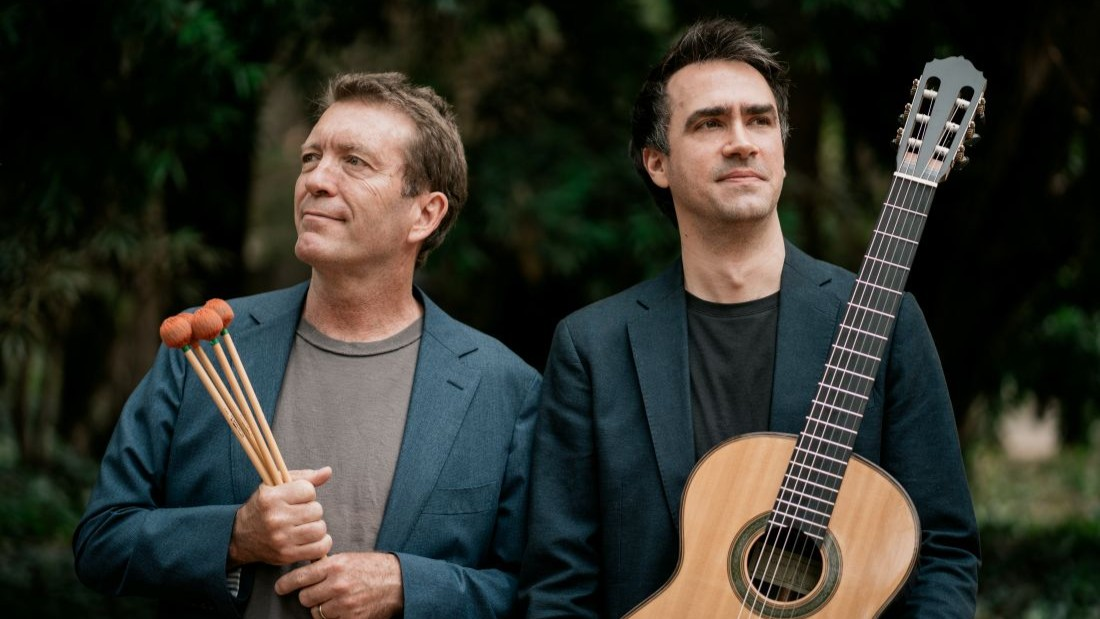
Exploring the past and future of classical guitar with Ascendent Messages
Ascendent Messages is an immersive concert featuring new works for classical guitar, percussion, and electronics. The show features acclaimed musicians Paul Tanner and Jonathan Fitzgerald, who will present the world premiere performance of four new commissions by award-winning Australian composers Maria Grenfell, Alice Humphries, Kate Milligan, and Kathy Potter. Ahead of a long-awaited performance at Callaway Music Auditorium on Saturday, February 8—and with tickets on sale now—BRAYDEN EDWARDS caught up with Jonathan Fitzgerald to find out more about classical guitar and what we can look forward to at the show.
For those of us that aren’t familiar with it, what is distinctive about classical guitar compared to other styles of playing?
There’s actually not a straightforward answer! The instrument itself is a bit different—it’s a “Spanish-style” acoustic guitar, with nylon strings and a smaller body and wider neck than its steel-string cousins.
And the technique is a bit different, especially noticeable with the right hand as we use our fingernails to pluck the strings instead of a guitar pick.
What really distinguishes it, however, is the music we play—whereas jazz and rock are largely improvisatory traditions, classical guitarists almost exclusively play notated music written in standard notation, drawing from a huge and varied repertoire composed all the way back in the Renaissance to the present day.
The percussion adds a whole new element as well! This combination of acoustic and percussion has been around for a long time. Have the technology and instruments changed much since this was first developed? Or is it still very close to its roots?
These instruments are largely unchanged from their original ancestors, though there have certainly been incremental improvements.
Over the last 50 years or so, classical guitar builders have been searching for ways to improve two of the guitar’s main weaknesses—a lack of volume and a lack of sustain—by experimenting with soundboard bracing and construction, alongside the use of modern materials like carbon fibre.
The guitar I’ll be playing is a “double-top” design, where the soundboard (normally a single piece of wood) is actually made from two very thin pieces of wood that are glued together with a sheet of Nomex in between them (Nomex is a honeycomb-like material normally used in fire protection and aircraft construction).
The result is a soundboard that’s very rigid but incredibly light, giving more volume and depth of sound than would be possible with a traditional soundboard design.
Visually, however, the instrument is indistinguishable from a guitar built 150 years ago, and it’s still no match for the massive volume of a marimba—for this concert I’ll be using a mic and amp!
And how about classical guitar playing in Australia generally? Do we have a distinctive flavour to our style of playing, as we often do with other genres of music?
I wouldn’t say there’s a distinctive Australian style of guitar playing, but there is definitely a distinctive Australian style of guitar building, and that was actually pioneered by a WA-based luthier in Esperance called Greg Smallman.
He developed a new approach to soundboard construction that has been copied by guitar builders around the world and has very much become synonymous with the “Australian sound.”
These performances will have electronic elements as well. How does this, obviously newer technology, complement the works?
Two of the works incorporate electronics, which play an integral role in the piece. Kathy Potter’s Space Junk uses live looping, which is when musical material gets recorded in real time and is then played back in perpetuity, becoming part of the musical fabric.
New material is then played live over that repeated ‘loop,’ which also gets recorded and played back, and then new material is played and looped—you get the idea. The result is a cacophony of musical fragments endlessly floating around and intersecting each other, a musical depiction of the countless chunks of space debris speeding around in Earth’s orbit.
The other work to utilise an electronic element is Kate Milligan’s Red Earth Mine, which is about the iron ore extraction industry in WA (Kate’s father and grandfather worked on iron ore mines).
As the guitarist and percussionist have to manage with increasingly limited resources (the range and dynamics for both players get smaller and smaller over the course of the work), we are accompanied by an archival recording of a mine blast that is looped and manipulated.
Despite a lot of time passing since its early days, women are still very underrepresented in guitar and percussion. This show is all about shifting that balance and highlighting the work of female composers in Australia. Why was this something you wanted to build a show around?
The idea for this project actually came about because of our students. Paul and I both teach at the UWA Conservatorium of Music, and back in 2023 we were planning a collaboration concert between the guitar students and percussion students.
I think it’s pretty well known that female composers are underrepresented in the western art music canon, but it became painfully clear in the process of planning the repertoire for that concert that the guitar+percussion genre was one in which gender-diverse composers were particularly poorly represented. We’ve still got a long way to go, but a project like this one seemed like a great way to start to shift that balance.
And the four composers that were chosen for this piece. What was it that made them stand out to you?
Paul and I were familiar with the work of all four composers, and we approached them to write for us because, aside from them being amazing composers, they each have a very distinct style and compositional approach. We wanted to have a lot of variety and musical diversity in the program, and we definitely got that in the final works.
What did you learn as a musician through studying and rehearsing these works? And what do you hope audiences get out of the experience of watching it performed?
It’s always an exciting adventure commissioning new music—you never know what you’re going to get, and you’ve got to find a way to get into the sound world and musical language of each individual composer.
These four works are so drastically different in their style and aesthetic, it really required us to cultivate a different approach for each one and to be able to switch gears quite quickly between pieces. I hope that for the audience it’s an enjoyable journey of discovery and that we’re able to do the pieces justice on the night!
For those interested in seeing more shows like this, not just through Fringe but throughout the year, what kinds of places or events can we see guitar and percussion performed at?
Despite classical guitar and percussion being quite common instruments, hearing them performed as a duo is not so common—I think the last performance in Perth would have been our UWA students back in 2023, and from memory the last one before that would have been 2018 at the Perth International Classical Guitar Festival. Who knows when the next one will be, so don’t miss this concert!
Ascendent Messages is showing at Callaway Music Auditorium on Saturday, February 8, 2025. Tickets are on sale now from fringeworld.com.au
